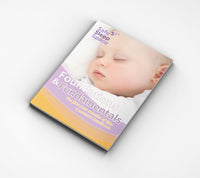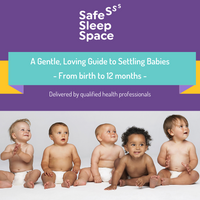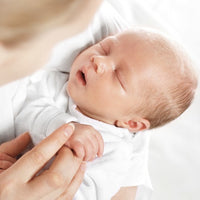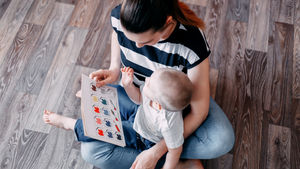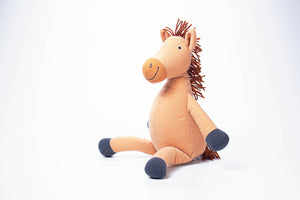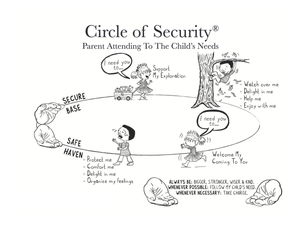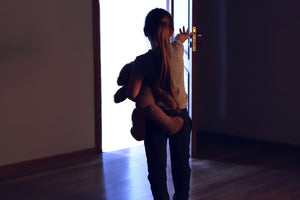Help! My baby’s moving around the cot and getting their arm or leg stuck

At some point in time, all babies progress from lying pretty much in the same position in their cot to moving around. Although this is a good thing and we want our babies to be active, it can also be a challenge to manage, especially in the early stages as they’re learning new skills.
Rolling, pushing, squirming and reaching, all increase the potential for one small arm or leg, even both, to escape through the cot rails. This generally causes distress as the baby becomes stuck and feels frustrated. With time and practice, they learn what’s involved in retracting their arm or leg, though in the transition period, they often need their parent’s help.
Why can’t you just learn to pull your arm or leg back?
Babies take time to learn new skills and like us, need a lot of practice to become competent. They don’t deliberately set out to make their parent’s lives challenging – much of their behaviour is due to the fact that they are small and for most of their waking time, they’re learning.
Babies don’t know that they can control the movement of their arms and legs until at least they’re six months old. Much of their movements until then are motivated by reflexes and impulses. They learn about cause and effect, reaching and grabbing, controlling their limbs and body through hundreds of hours of practice.
Can’t I use a bumper in my baby’s cot?
Bumpers are not a safe option to use in a baby’s cot. Any soft bedding is dangerous and should not be used. This is because it can cover the baby’s face and obstruct their breathing. Another risk with bumpers is that the baby’s head can become trapped between the cot rails and the bumper. Ties which secure a cot bumper can also be a choking/strangulation hazard.
Bumpers, like pillows and other soft blankets and bedding, can also be used as a ‘step’ for climbing and falling out of a cot. Always follow the guidelines on how to make up a safe cot.
Don’t be in too much of a hurry!
Babies who get an arm or leg out through their cot rails can protest very loudly, though in the process of settling, sometimes it’s easy to assume the baby is crying because they’re resisting going to sleep. In fact, they could be crying because they have an arm or leg out.
It’s important to check on your baby regularly when they’re settling, to make sure they’re positioned safely in their cot and don’t have an arm or leg stuck through the cot rails.
Some tips on checking:
- Do this as quietly as possible.
- Try not to let your baby see you. A monitor is a good option.
- If your baby has an arm or leg out, isn’t bothered by this and has shown skills in being able to pull their arm or leg back into the cot, try to leave them.
Don’t be in too much of a hurry to help your baby pull their arm/leg back into the cot. Through challenges come learning opportunities. In the early stages you will need to help your baby more, though as they get older and practice their skills, they’ll need less assistance.
Nat’s top tips for managing newly mobile babies
We asked Natalie van Winckel, early childhood educator and Safe Sleep Space sleep consultant, for her top tips to help newly mobile babies manage cot mobility.
Here are Nat’s top suggestions:
- Use an arms out sleeping bag to support your baby’s sleep. Check the recommendations by Red Nose relating to important safety features.
- Offer your baby some quiet time in their cot before they go off to sleep. This will help them to get used to their cot and practice their moving skills. Your baby can also go into their cot through the day so they can become more familiar with the boundaries of their cot and learn how to move comfortably in this space.
- Always place your baby on their back for sleeps, both night and day. If they move around, support their exploration. From around 5-6 months of age, babies start rolling, though it takes a few weeks for them to become skilful at rolling both ways. A pre-settling massage, reassuring cuddle and re-position onto their back can help to support settling after wind-down time in the cot.
- Check your baby’s position in their cot after they have settled. If they do have an arm or leg out gently place their limb back onto the mattress, though avoid repositioning your baby’s body. If they wake because their arm or leg is stuck, reassure them and move their arm or leg back onto the mattress. Help your baby if they need this to reposition their body in the cot.
- Remember, this time is not forever. Like us, babies learn about proprioception – spacial awareness when awake and sleeping. Support their development by offering lots of floor and tummy time each day, crawling activities and reaching for their favourite toy.
- You can book a call with a sleep consultant for even more one on one guidance for your baby.
Remember
- Lots of floor time each day provides a great opportunity for babies to learn how to roll and control their arms and legs. Support your baby’s attempts to reach and grab, then retract their arm.
- Babies who are overfed and gain a lot of weight tend to be less active than babies who are in a healthy weight range. Like adults, a baby’s movement is affected by their weight and size. Speak with your Child Health Nurse about your baby’s growth and risk factors for babies to become overweight and/or obese.
- Avoid dressing your baby in restrictive clothing which may inhibit their ability to move. Denim and other stiff fabrics used in jeans and overalls can restrict free movement.
- Place toys on the floor just out of your baby’s reach. This will help them to learn movement skills.
- It’s always better to offer multiple, shorter periods of supervised floor time each day than 1-2 ‘marathon’ sessions.
- Expect your baby’s tolerance for floor time to be affected by what else is going on in their day. If they’re tired, hungry, bored or cranky they won’t enjoy floor time.
- Every baby is an individual and will develop skills in their own way.
- Speak with your Child Health Nurse if you are concerned about any aspect of your baby’s development.
Our Free Sleep Charts share your baby's sleep cycles and includes tables to easily explain how much sleep your baby needs.
For personalised help to understand your baby's sleep and settling needs, book a call with one of our professional sleep consultants.
Written for Safe Sleep Space by Jane Barry, Midwife and Child Health Nurse.
References:
Cot safety - safety alert (accc.gov.au)
Safe sleep for babies | Pregnancy Birth and Baby (pregnancybirthbaby.org.au)

